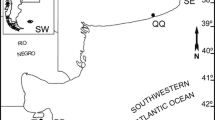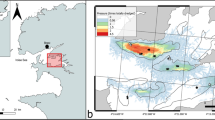Abstract
Evidence from over 200 sediment cores, numerous submersible dives, and bottom photographs prove that bioturbation and bioerosion are ongoing processes affecting northeastern U.S. continental slope and rise sedimentation. Evidence of biological activity was found in greater than 95% of the cores examined. Submersible dive observations reveal that the results of biological activity often dominate sea-floor microtopography. Bioturbation can disturb sediments several centimeters deep in a matter of seconds and is in some areas the primary sediment transport mechanism. Many cores with sandy intervals were profoundly disturbed by bioturbation. Biologically camouflaged sand-rich intervals can easily be missed by visual observation.
Similar content being viewed by others
References
Milliman, J. D., Pilkey, O. H., and Ross, D. A., 1972. Sediments of the continental margin off the eastern United States. Geological Society of America Bulletin, v. 83, pp. 1315–1334.
Kelling, G., Sheng, H., and Stanley, D. J., 1975. Mineralogic composition of sand-sized sediment on the outer margin off the Mid-Atlantic States: assessment of the influence of the ancestral Hudson and other fluvial system. Geological Society of America Bulletin, v. 86, pp. 853–862.
Doyle, L. J., Pilkey, O. H., and Woo, C. C., 1979. Sedimentation on the eastern United States continental slope. Society of Economic Paleontologists and Mineralogists, Special Publication No. 27, pp. 119–129.
Richter, R., 1952. Fluidal-texture in Sediment-Gesteinen und Über Sedifluktion Überhaupt: Notizblatt Hessische Landsamt Bodenforsch, v. 3, pp. 67–81.
Piper, D., and Marshall, N., 1969. Bioturbation of Holocene sediments on La Jolla deep-sea fan, California. Journal of Sedimentary trology, v. 39, pp. 891–901.
Hecker, B., 1982. Possible benthic fauna and slope instability relationships. In: S. Saxov and J. Niewenhuis (eds.), Marine Slides and Other Mass Movements. Marine Science Series, Plenum Press, New York, v. 6, pp. 335–347.
Rhoads, D. C., Aller, R. C., and Goldhaber, M. B., 1977. The influence of colonizing benthos on physical properties and chemical diagenesis of the estuarine seafloor. In: B. C. Coull (ed.), Ecology of Marine Benthos, Belle W. Baruch Library in Marine Science No. 6, Columbia, S.C., pp. 113–138.
Rowe, G., Kelle, G., Edgerton, H., Staresinic, N., and Macillvaine, J., 1974. Time-lapse photography of the biological reworking of sediments in Hudson Submarine Canyon. Journal of Sedimentary Petrology, v. 44, pp. 549–552.
Paul, A., Thorndike, E., Sullivan, L., Heezen, B., and Gerard, R., 1978. Observations of the deep-sea floor from 202 days of time lapse photography. Nature, v. 272, pp. 812–814.
Stanley, D. J., 1971. Bioturbation and sediment failure in some submarine canyons. Vie et Milieu (France), supplément, v. 22, pp. 541–555.
Malahoff, A., Embley, R. W., and Fonari, D. J., 1979. Geological observations from the ALVIN of the continental margin from Baltimore Canyon to Norfolk Canyon. EOS Transactions, American Geophysical Union, v. 6018, pp. 287.
Dillon, W. P., and Zimmerman, H. B., 1970. Erosion by biological activity in two New England submarine canyons. Journal of Sedimentary Petrology, v. 40, pp. 542–547.
Ryan, W., Cita, M. B., Miller, E. L., Hanselman, D., Nesteroff, W. D., Hecker, B., and Nibbelink, M., 1978. Bedrock geology in New England submarine canyons. Oceanologica Acta, v. 1, pp. 233–254.
Stubblefield, W., McGregor, B., Forde, E., Lambert, D., and Merrill, G., 1982. Reconnaissance in DSRV Alvin of a fluvial-like meander system in Wilmington Canyon and slump features in South Wilmington Canyon. Geology, v. 10, pp. 31–36.
Stanley, D. J., Sheng, H., Lambert, D., Rona, P. A., McGrail, D., and Jenkyns, J. S., 1981. Current-influenced depositional provinces, continental margin off Cape Hatteras, identified by petrologic method. Marine Geology, v. 40, pp. 215–235.
Berger, W., Ekdale, A., and Bryant, P., 1979. Selective preservation of burrows in deep-sea carbonates. Marine Geology, v. 32, pp. 205–230.
Turekian, K., Cochran, J., and DeMaster, D., 1978. Bioturbation in deep-sea deposits: rates and consequences. Oceanus, v. 21, pp. 34–41.
Forde, E., Stanley, D. J., Sawyer, W. B., and Slager, K. J., 1981. Sediment transport in Washington and Norfolk Submarine Canyons. Applied Ocean Research, v. 3, p. 59.
Author information
Authors and Affiliations
Rights and permissions
About this article
Cite this article
Forde, E.B., Ulrich, S.D. & Hecker, B. Biological disturbance and camouflage of sedimentary features on the Northeast United States slope and rise. Geo-Marine Letters 4, 49–53 (1984). https://doi.org/10.1007/BF02237974
Received:
Revised:
Issue Date:
DOI: https://doi.org/10.1007/BF02237974




